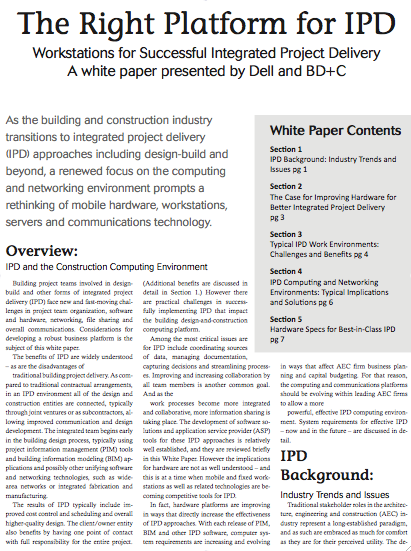Building project teams involved in design- build and other forms of integrated project delivery (IPD) face new and fast-moving chal- lenges in project team organization, software and hardware, networking, file sharing and overall communications. Considerations for developing a robust business platform is the subject of this white paper. The benefits of IPD are widely understood – as are the disadvantages of traditional building project delivery. As com- pared to traditional contractual arrangements, in an IPD environment all of the design and construction entities are connected, typically through joint ventures or as subcontractors, al- lowing improved communication and design development. The integrated team begins early in the building design process, typically using project information management (PIM) tools and building information modeling (BIM) ap- plications and possibly other unifying software and networking technologies, such as wide- area networks or integrated fabrication and manufacturing. To read more, click on the link below.
http://www.accelacomm.com/jaw/source/47/51413219/
Related Stories
| Aug 19, 2011
Underfloor air distribution, how to get the details right
Our experts provide solid advice on the correct way to design and construct underfloor air distribution systems, to yield significant energy savings.
| Aug 19, 2011
Enhanced acoustical design
Ambient noise levels in some facility types are trending up and becoming a barrier to clear communication between building occupants.
| Jul 22, 2011
High-performance windows and doors
Learning objectives After reading this article, you should be able to: Understand issues of thermal performance and energy efficiency in relation to window and door systems; describe optimal detailing of the window-wall interface and how it contributes to building performance, sustainability, and occupant well-being; understand how durability contributes to sustainable windows/doors; and list sustainable O&M requirements for window and door systems.
| Jul 21, 2011
Falling Architecture Billings Index reflects decrease in design demands
This months Architecture Billings Index (ABI), provided by the American Institute of Architects, is almost a full point lower than last month’s reported score. June’s reading of 47.2 was short of the required 50 to achieve billings increases, making July’s reading of 46.3 an unwelcome sign of market tidings.
| Jun 29, 2011
New leadership role for architects in net-zero design
BD+C Editorial Director Rob Cassidy talks with RNL Design's Tom Hootman, AIA, about the changing role of architects in net-zero designs.














